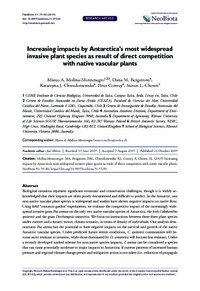Mostrar el registro sencillo de la publicación
Increasing impacts by Antarctica’s most widespread invasive plant species as result of direct competition with native vascular plants
| dc.contributor.author | Molina-Montenegro, Marco A. | |
| dc.contributor.author | Bergstrom, Dana M. | |
| dc.contributor.author | Chwedorzewska, Katarzyna J. | |
| dc.contributor.author | Convey, Peter | |
| dc.contributor.author | Chown, Steven L. | |
| dc.date.accessioned | 2023-03-22T17:43:05Z | |
| dc.date.available | 2023-03-22T17:43:05Z | |
| dc.date.issued | 2019 | |
| dc.identifier.uri | http://repositorio.ucm.cl/handle/ucm/4555 | |
| dc.description.abstract | Biological invasions represent significant economic and conservation challenges, though it is widely acknowledged that their impacts are often poorly documented and difficult to predict. In the Antarctic, one non-native vascular plant species is widespread and studies have shown negative impacts on native flora. Using field “common garden” experiments, we evaluate the competitive impact of the increasingly widespread invasive grass Poa annua on the only two native vascular species of Antarctica, the forb Colobanthus quitensis and the grass Deschampsia antarctica. We focus on interactions between these three plant species under current and a future, wetter, climate scenario, in terms of density of individuals. Our analysis demonstrates Poa annua has the potential to have negative impacts on the survival and growth of the native Antarctic vascular species. Under predicted future wetter conditions, C. quitensis communities will become more resistant to invasion, while those dominated by D. antarctica will become less resistant. Under a recently developed unified scheme for non-native species impacts, P. annua can be considered a species that can cause potentially moderate to major impacts in Antarctica. If current patterns of increased human pressure and regional climate change persist and mitigation action is not taken (i.e. reduction of propagule pressure and eradication or control measures), P. annua is likely to spread in Antarctica, especially in the Antarctic Peninsula region, with significant negative consequences for some of the most remote and pristine ecosystems worldwide. Tighter biosecurity across all operators in the region, improved surveillance for the species, and prompt, effective control actions will reduce these risks. | es_CL |
| dc.language.iso | en | es_CL |
| dc.rights | Atribución-NoComercial-SinDerivadas 3.0 Chile | * |
| dc.rights.uri | http://creativecommons.org/licenses/by-nc-nd/3.0/cl/ | * |
| dc.source | NeoBiota, 51, 19-40 | es_CL |
| dc.subject | Invasions | es_CL |
| dc.subject | Poa annua | es_CL |
| dc.subject | Climate change | es_CL |
| dc.subject | Competition | es_CL |
| dc.subject | Antarctic ecosystems | es_CL |
| dc.title | Increasing impacts by Antarctica’s most widespread invasive plant species as result of direct competition with native vascular plants | es_CL |
| dc.type | Article | es_CL |
| dc.ucm.indexacion | Scopus | es_CL |
| dc.ucm.indexacion | Isi | es_CL |
| dc.ucm.uri | neobiota.pensoft.net/article/37250/ | es_CL |
| dc.ucm.doi | doi.org/10.3897/neobiota.51.37250 | es_CL |



